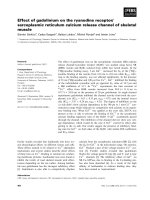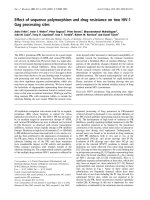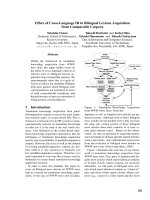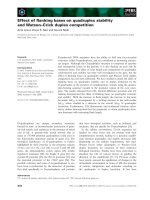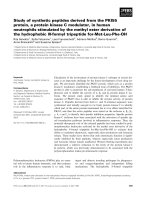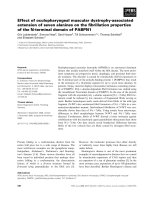Báo cáo khoa học: "Effect of Utilizing Terminology on Extraction of Protein-Protein Interaction Information from Biomedical Literature" ppt
Bạn đang xem bản rút gọn của tài liệu. Xem và tải ngay bản đầy đủ của tài liệu tại đây (446.91 KB, 4 trang )
Effect of Utilizing Terminology on Extraction of Protein-Protein
Interaction Information from Biomedical Literature
Junko Hosaka
Judice L.Y. Koh
Akihiko Konagaya
RIKEN
Institute for Infocomm Research RIKEN
Genomic Sciences Center
21 Heng Mui Keng Terrace,
Genomic Sciences Center
Suehiro-cho 1-7-22
Singapore 119613
Suehiro-cho 1-7-22
Tsurumi-ku, Yokohama,
Tsurumi-ku, Yokohama,
Kanagawa, Japan
Kanagawa, Japan
Abstract
As the amount of on-line scientific litera-
ture in the biomedical domain increases,
automatic processing has become a prom-
ising approach for accelerating research.
We are applying syntactic parsing trained
on the general domain to identify protein-
protein interactions. One of the main dif-
ficulties obstructing the use of language
processing is the prevalence of special-
ized terminology. Accordingly, we have
created a specialized dictionary by com-
piling on-line glossaries, and have ap-
plied it for information extraction. We
conducted preliminary experiments on
one hundred sentences, and compared the
extraction performance when (a) using
only a general dictionary and (b) using
this plus our specialized dictionary. Con-
trary to our expectation, using only the
general dictionary resulted in better per-
formance (recall 93.0%, precision 91.0%)
than with the terminology-based
approach (recall 92.9%, precision 89.6%).
1 Introduction
With the increasing amount of on-line literature
in the biomedical domain, research can be greatly
accelerated by extracting information automati-
cally from text resources. Approaches to auto-
matic extraction have used co-occurrence
(Jenssen, 2001), full parsing (Yakushiji, 2001),
manually built templates (Blaschke, 2001), and a
natural language system developed for a
neighboring domain, with modifications e.g. re-
garding semantic categories (Friedman, 2001).
In order to extract information such as protein-
protein interactions from scientific text, it is in-
sufficient to check only co-occurrences. Con-
structing a satisfactory set of rules for full parser
is quite complex and the processing requires a
tremendous amount of calculation.
One of the main difficulties in using language
processing in the biomedical domain is the preva-
lence of specialized terminology, including pro-
tein names. It is impossible to obtain a complete
list of protein names in the current rapidly devel-
oping circumstances: notations vary, and new
names are steadily coined. To bypass these prob-
lems, we start with words expressing interactions,
and then seek the elements which are actually
interacting, based on the syntactic structure.
These elements may be the proteins which inter-
est us. We are using the Apple Pie Parser ver.5.9
1
,
a syntactic parser trained on the Penn Tree Bank
(PTB) (recall 77.45%, precision 75.58%).
2 Data Preparation
We restricted test sentences to syntactically well-
formed ones, so that we could examine the ade-
quacy of our syntactically-based extraction rules.
We assumed that a general-purpose dictionary
(GPD) obtained from the PTB would be insuffi-
cient for handling biomedical literature. There-
fore, we combined on-line glossaries to construct
our own terminology dictionary, which we call
the Medical Library Dictionary (MLD).
ks/projects/proteus/app/
107
2.1 Test Sentences
MeSH represents unique terms, and includes
synonyms as well as chemical names:
We received from a biologist a list of words de-
noting interactions and 1000 abstracts retrieved
from Medline using the PubMed
2
. These ab-
stracts are related to Interleukin-6, a secreted pro-
tein whose main function is to mediate in-
flammatory response in the body. Medline is the
bibliographic database of the National Library of
Medicine (NLM) in the United States. PubMed is
an NLM service which provides access to Med-
line and additional life science journals.
Out of the word list, we focused on "activate",
as this can effectively express the interaction of
two elements. We first ran the syntactic parser on
the sentences containing the string "activat*
3
",
then picked only sentences that contain the verbal
"activat*". There were approximately 1000 such
sentences. Second, we consulted the sentences
annotated by two professional annotators. They
marked phrases containing verbal "activat*" and
the corresponding agents and recipients. They
also evaluated the parsing results related to the
phrases. We then selected 100 sentences ran-
domly from the sentences to which both annota-
tors gave the same marking and same evaluation.
To determine the reliability of the annotators'
judgment and the difficulty of the task, we calcu-
lated the KAPPA coefficient of their responses,
and found it to be 0.54 (Hosaka and Umetsu,
2002). This degree of agreement can be inter-
preted as "moderate" (Carletta, 1997).
2.2 The Medical Library Dictionary
We assumed that biological, chemical, and medi-
cal terminology is used in our domain. Therefore,
the MLD was compiled from four glossaries in
these areas: Biochemical Glossary
4
(BG), Can-
cernet Dictionary
5
(CD), Medical Chemistry Dic-
tionary
6
(MCD) and Life Science Dictionary
(LSD). In addition to the MLD, we used the
Medical Subject Headings (MeSH
8
). MeSH is a
controlled vocabulary created by the NLM. We
used the C chapter (Diseases). The dictionary
size is given in Table 1. The number of terms for
2
httn://www.ncbi.nlm.nih.eoy/entrez/uticry.fcei
3
"*" indicates any string.
4
htty://www.fhsu.cduichcmistry/twicsag1ossary/biochcmelossary.htm
5
/>6
tiltp://www.chem.qmw.ac.uldiupacimedchem/
7
/>8
/>Dictionary Source glossary
Number of terms
MLD
BG
723
CD
2,414
MCD
122
LSD
32,405
MeSH MeSH
300,263
Table 1. Size of terminology dictionaries
The MLD contained 32,698 unique terms and the
GPD 88,707 words. We then removed MLD
terms which already were listed in the GPD. This
removal resulted in a reduced MLD consisting of
25,772 terms (uniMLD). In addition, there were
401 duplicated terms found in both the MeSH
and the MLD. In this case, we retained the words
in the MLD, so that the number of MeSH terms
decreased to 300,263 (uniMeSH). For the ex-
periment, we used the combination of uniMLD
and uniMeSH (MLD-M). When we used both
GPD and MLD-M, we called this combination
MLD+. Table 2 summarizes the dictionary sizes:
Dictionary Number of terms
GPD
88,707
MLD+
MLD-M
uniMLD
25,772
uniMeSH
119,599
Table 2. Size of dictionaries used for experiment
Among the four glossaries, only the LSD had
part of speech (POS), since it was a bilingual re-
source. The MeSH had only nouns. In the other
three glossaries, the POS has not been defined.
Our parser included out-of-vocabulary handling
We supposed, however, that appropriate POS
would raise the performance Therefore, we as-
signed POS to these entries semi-automatically.
3 Extraction Rules
We manually defined extraction rules for active
and passive sentences. We converted the parsing
output into XML format, and then applied the
rules. The following example illustrates the pro-
cedure. The parser can print the parsing results in
several ways, with or without POS. Our extrac-
tion rules do specify POS; however, for simplic-
ity, we suppress them in the example below.
108
Input sentence:
We find that ACK-2 can be
activated by cell adhesion
Cdc42-dependent manner.
We measured our system's recall and precision
rates shown in Table 4 as follows:
Recall: Al (A+B)
in a
Precision: Al (A+C)
Syntactic structure in XML:
<S><NPL
9
>We</NPL><VP>find
<SBAR>that<SS
10
>
<NPL>ACK-2</NPL>
<VP>can<VP>be<VP>activated
<PP>by<NPL>cell adhesion</NPL></PP>
<PP>in
<NPL>a Cde42-dependent manner</NPL></PP>
</VP><NP><NP></SS></SBAR></VP>.</S>
Extraction steps:
•
Find a VP "activat*" as a starting word.
•
Extract the highest VP containing "acti-
vat*" up to the point where a PP headed by
"by" is encountered.
4
"can be activated"
•
Find the nearest NP/NPL to the left of the
"activat*" phrase.
•
Extract the highest NP/NPL.
4
"ACK-2"
4 Preliminary Evaluation
We applied our extraction rules to two sets con-
sisting of the parsing outputs from 100 sentences:
parsing with the GPD and with the MLD+.
To measure the extraction performance, we
prepared a gold standard: a biologist marked
phrases containing verbal "activat*" and its cor-
responding interacting entities. We regarded sys-
tem extractions as correct if they contained the
marked phrases.
The matrix shown in Table 3 defines three
combinations of gold standard and system extrac-
tion results, A, B, and C:
Gold Standard
System
A
extracted extracted
B
extracted not extracted
C
not extracted
extracted
Table 3. Evaluation matrix
Recall % Precision %
GPD
MLD+
GPD
MLD+
VP
98.9 97.9 94.9 93.9
Agent
83.3
86.4
80.6
88.4
Recipient
96.6
94.2
87.6
86.2
All
93.0
92.9
91.0
89.6
Table 4. Extraction performance
We found that it is most difficult to extract an
Agent. For this task only, use of our MLD+ im-
proved the system's performance. For other
phrases, however, the system performed slightly
better when the GDP alone was used.
5 Effect of Specialized Terminology
Our 100 sentences contained about 2,500 words.
From the MLD-M, 236 terms (uniMeSH 48, un-
iMLD 188) were identified. That is, specialized
terms contributed about 9 percent of all words. If
we consider that the uniMLD is about one-third
the size of the GPD, as shown in Table 2, the ac-
tual hit rate for terms turned out to be rather low.
As shown in Table 4, use of a terminology dic-
tionary does not always raise the extraction per-
formance. We analyzed sentences from which the
information was correctly extracted when only
the GPD was used but erroneously extracted
when the MLD+ was used. There were six sen-
tences with nine such cases. We found the fol-
lowing three reasons for negative effects:
1.
A POS was incorrectly assigned for the
context (three cases)
2.
A term was correctly identified, but a
multi-word building failed (two cases)
3. A POS was correctly assigned, but a
phrase building failed (four cases)
Some examples follow. In these, the categories
were taken from the PTB " . On the left is the
parsing result with the GPD only, and on the
right is that with the MLD+:
NFL is a specific category for the parser, representing the lowest NP.
19
SS is a specific category for the parser, representing an S which is not the
top S.
NNPX is a specific category of the Apple Pie Parser, representing NNP or
NNPS.
109
11 S
T 115'
0
-1
PP'
COMMA'
11
NPL
.
D
DT both
D
NNPX Cdk4
D
CC: and
D
NNPX Cdk6
D
VDD were
11
,
/ls"
n
VON' activated
D
PERIOD
5 NI s
T 118'
ti
PE'
COMMA'
11
NPL
.
D
DT both
D
NNPX Cdk4
D
CC: and
D
NNPX Cdk6
VP
D
VDD were
5
ADJP•
n
TY activated
D
PERIOD
vF
VBN: activated
PP.
Di IN' by
NP:
NFL:
D
JJ. direct
D
CD: tyrosine
IINPL.
▪
NNS: phosphorylation
D
PERIOD
D
VIBEr was
VP
D
VI3N. activated
ti
ADJP
IIPIs"
D
IN by
9 11
NFL
J.T direct
D
NNS. tyrosine
5
ti
NPL:
D
NNS:
phosphorylation
D PERIOD'
With GPD
5
•
SPAR
D
IN that
▪
ss.
IINPL
D NNPX CNF1
11 VP:
D
VBEr activated
5
11NPL:
D
DT the
NNPX: Cdc42
D
CC: and
D
NNPX: Rae
11
NFL:
With MLD+
SBAR
ss.
5
IINPL
D
DT: that
D
NN CNF1
cc
VP:
D
VBD. activated
5
IINFrLi
r,
DT the
▪
NNPX• Cdc42
D
CC. and
▪ NNFIC: Rae
11
NFL:
In the presence of Tax, both Cdk4 and Cdk6 were activated.
With GPD
With MLD+
Figure
1. Failure in
POS assignment
In, the string "activated", which should be a verb,
was assigned falsely as an adjective. In the LSD,
"activated" is listed as both POS. This suggests
that "activated" is more often used as an adjec-
tive in this context in the general domain.
We recently found that PI3K was activated in vitro by direct
tyrosine phosphorylation.
With GPD
With MLD+
Figure 2. Failure in multi-word building
InFigure 2, the POS of "tyrosine" was correctly
assigned. However, the system failed to build a
multi-word-term with "phosphorylation".
Further, the appearance of suggested that CNF1 activated the
Cdc42 .
Figure 3. Failure in phrase construction
In Figure 3, "CNF 1 " got the right POS. However,
the preceding "that" is falsely assigned as a de-
terminer. Nouns may often be used with deter-
miners in the general domain.
6 Discussion and Conclusion
In this experiment, information extraction with a
general dictionary resulted in slightly better per-
formance than that with specialized dictionary.
Even if a POS is correctly assigned, parsing
can fail if the parser is trained on a different do-
main. To retrain a parser, an annotated corpus is
needed, though a construction of such a corpus
will be time consuming In the meantime, we
believe the best way is to represent domain-
specific structures manually through rules. We
observed cases where a term was correctly rec-
ognized but the system failed to identify a multi-
word-term. To cope with this problem, we will
further integrate terminology dictionaries, such as
the Unified Medical Language System
12
.
We conducted this experiment with a small set
of syntactically well-formed sentences. To exam-
ine the validity of the result, we are planning fur-
ther tests with more sentences.
Acknowledgement
We thank Dr. I. Kurochkin for his biomedical
advice and Dr. M. Seligman for reading the draft.
References
Blaschke, Christian and Valencia, Alfonso. 2001. The
potential use of SUISEKI as a protein interaction
discovery tool.
Genome Informatics,
12: 123-134.
Carletta, Jean, et al. 1997. The reliability of a Dia-
logue Structure Coding Scheme.
Computational
Linguistics,
23(1): 13-31.
Friedman, Carol, et.al
. 2001. GENIES: a natural-
language processing system for the extraction of
molecular pathways from journal articles.
Proc. of
ISMB,
17(Supp1.1): S74-S82.
Hosaka, Junko and Umetsu, Ryo. 2002. Toward the
extraction of protein-protein interaction informa-
tion from immunology literature.
Proc. of
IPSJ-
SIG-NL,150:
15-20.
Jenssen, Tor-Kristian, et al. 2001. A literature net-
work of human genes for high-throughput analysis
of gene expression.
Nature Genetics,
28: 21-28.
Yakushiji, Akane, et al. 2001. Event extraction from
biomedical papers using a full parser.
Proc. of
PSB,
6: 408-419.
12
iresearch/unils/
110



